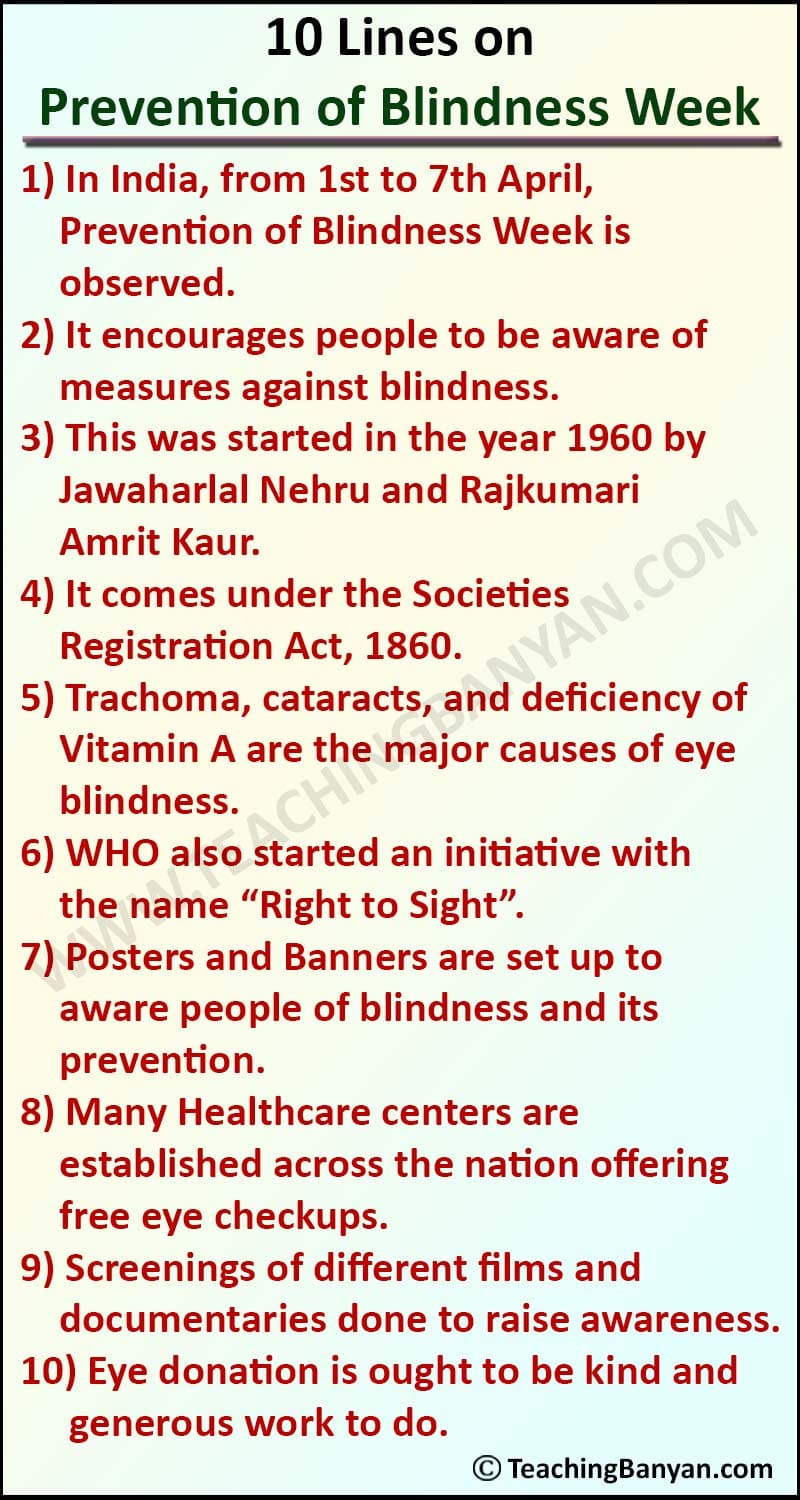Prevention of Blindness Week is celebrated every year from 1st April to 7th April to raise public awareness towards the condition of blind people in India. Blindness is a big issue and it creates a lot of painful experiences for the people who are suffering from it. There are multiple reasons which cause blindness like trachoma, cataract, Vitamin A deficiency, and malnutrition. The campaigns are organized by the government through print media and electronic media with an aim to educate people about various types of eye problems during the week-long celebration.
Ten Lines on Prevention of Blindness Week
Set 1
1) Prevention of Blindness Week is celebrated every year in India from 1st April to 7th April.
2) It is a national health awareness program focusing on factors causing blindness.
3) The week is observed to awaken people towards measures of preventing blindness.
4) Every year, government, NGOs and civil communities jointly hold an awareness programme on the elimination of causes of blindness during the week.
5) Around 39 million people worldwide are suffering from blindness and approximately 245 million people have low vision.
6) As per the statistics, around 16 million people in India are suffering from blindness problems and eye-related issues.
7) The states with the highest number of blind cases in India are Madhya Pradesh and Rajasthan.
8) The Prevention of Blindness Week creates awareness among people about eye problems, prevention, cure and treatments for blindness.
9) Eye donation is a kind initiative that has been taken by many people in India to provide real support to blind people.
10) Various events like free eye check-up campaigns, discussions, seminars are organized nationwide to celebrate Prevention of Blindness Week.
Set 2
1) Blindness is defined as the loss of the capability of vision.
2) There are many people in India suffering from the plight of blindness.
3) Every year the first week of April is observed as Prevention of Blindness week.
4) This programme has been initiated by the Government of India.
5) The campaign came into existence in 1960.
6) The national society for Prevention of Blindness was also established.
7) It was founded under the Societies Registration Act 1860 of the constitution.
8) The credit of this establishment and campaign goes to Jawaharlal Nehru and Raj Kumari Amrit Kaur.
9) Its vision is to raise awareness about blindness, its prevention and its cure.
10) The health workers from government departments participate in the awareness programs.

Set 3
1) Blindness is a miserable and painful condition.
2) India celebrates the Prevention of Blindness from 1st April-7th April annually.
3) It is observed to make people aware of the importance of the eyes.
4) It is very important for everyone to take good care of their eyes.
5) People must go for regular eye checkups.
6) There must be an immediate cure if any eye infection has been diagnosed.
7) The campaign also encourages people for eye donation.
8) It will be a great step in reducing the misery of blind people.
9) Governmental departments and Non-governmental agencies participate in the campaign.
10) Several eye check-up camps are set up on that day to ensure the vision of the campaign.
Set 4
1) In India, from 1st to 7th April, Prevention of Blindness Week is observed. It encourages people to be aware of measures against blindness.
2) This was started in the year 1960 by Jawaharlal Nehru and Rajkumari Amrit Kaur.
3) It comes under the Societies Registration Act, 1860.
4) Trachoma, cataracts, and deficiency of Vitamin A are the major causes of eye blindness.
5) WHO also started an initiative with the name “Right to Sight”.
6) Posters and Banners are set up to aware people of blindness and its prevention.
7) Many Healthcare centers are established across the nation offering free eye checkups.
8) Screenings of different films and documentaries done to raise awareness.
9) Eye donation is ought to be kind and generous work to do.
10) NGOs work with govt. to distribute free educational materials.
Prevention of Blindness Week provides a unique opportunity to make people alert and aware of the factors causing eye-related problems and blindness. Blindness has affected more than 40 million people worldwide and almost one out of every three people in India is suffering from eye-related problems. The government, civil communities, and NGOs should work in collaboration in order to take concrete steps for the prevention, cure, and treatment of eye-related problems, eye injuries, visual impairments, and blindness.
